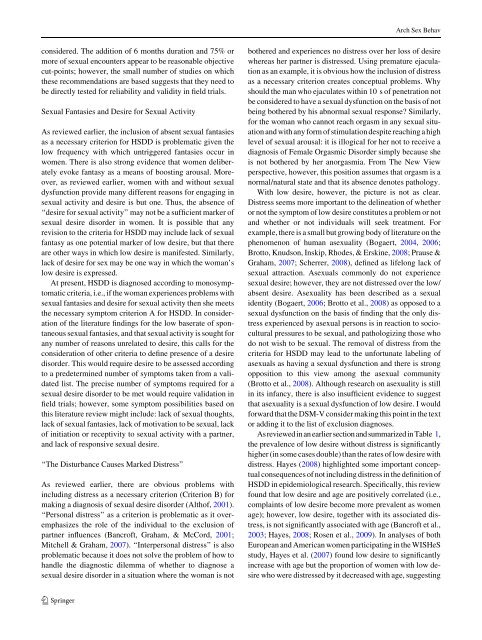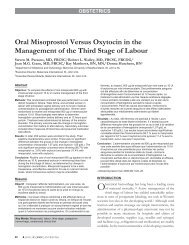The DSM Diagnostic Criteria for Hypoactive Sexual Desire Disorder ...
The DSM Diagnostic Criteria for Hypoactive Sexual Desire Disorder ...
The DSM Diagnostic Criteria for Hypoactive Sexual Desire Disorder ...
Create successful ePaper yourself
Turn your PDF publications into a flip-book with our unique Google optimized e-Paper software.
Arch Sex Behav<br />
considered. <strong>The</strong> addition of 6 months duration and 75% or<br />
more of sexual encounters appear to be reasonable objective<br />
cut-points; however, the small number of studies on which<br />
these recommendations are based suggests that they need to<br />
be directly tested <strong>for</strong> reliability and validity in field trials.<br />
<strong>Sexual</strong> Fantasies and <strong>Desire</strong> <strong>for</strong> <strong>Sexual</strong> Activity<br />
As reviewed earlier, the inclusion of absent sexual fantasies<br />
as a necessary criterion <strong>for</strong> HSDD is problematic given the<br />
low frequency with which untriggered fantasies occur in<br />
women. <strong>The</strong>re is also strong evidence that women deliberately<br />
evoke fantasy as a means of boosting arousal. Moreover,<br />
as reviewed earlier, women with and without sexual<br />
dysfunction provide many different reasons <strong>for</strong> engaging in<br />
sexual activity and desire is but one. Thus, the absence of<br />
‘‘desire <strong>for</strong> sexual activity’’ may not be a sufficient marker of<br />
sexual desire disorder in women. It is possible that any<br />
revision to the criteria <strong>for</strong> HSDD may include lack of sexual<br />
fantasy as one potential marker of low desire, but that there<br />
are other ways in which low desire is manifested. Similarly,<br />
lack of desire <strong>for</strong> sex may be one way in which the woman’s<br />
low desire is expressed.<br />
At present, HSDD is diagnosed according to monosymptomatic<br />
criteria, i.e., if the woman experiences problems with<br />
sexual fantasies and desire <strong>for</strong> sexual activity then she meets<br />
the necessary symptom criterion A <strong>for</strong> HSDD. In consideration<br />
of the literature findings <strong>for</strong> the low baserate of spontaneous<br />
sexual fantasies, and that sexual activity is sought <strong>for</strong><br />
any number of reasons unrelated to desire, this calls <strong>for</strong> the<br />
consideration of other criteria to define presence of a desire<br />
disorder. This would require desire to be assessed according<br />
to a predetermined number of symptoms taken from a validated<br />
list. <strong>The</strong> precise number of symptoms required <strong>for</strong> a<br />
sexual desire disorder to be met would require validation in<br />
field trials; however, some symptom possibilities based on<br />
this literature review might include: lack of sexual thoughts,<br />
lack of sexual fantasies, lack of motivation to be sexual, lack<br />
of initiation or receptivity to sexual activity with a partner,<br />
and lack of responsive sexual desire.<br />
‘‘<strong>The</strong> Disturbance Causes Marked Distress’’<br />
As reviewed earlier, there are obvious problems with<br />
including distress as a necessary criterion (Criterion B) <strong>for</strong><br />
making a diagnosis of sexual desire disorder (Althof, 2001).<br />
‘‘Personal distress’’ as a criterion is problematic as it overemphasizes<br />
the role of the individual to the exclusion of<br />
partner influences (Bancroft, Graham, & McCord, 2001;<br />
Mitchell & Graham, 2007). ‘‘Interpersonal distress’’ is also<br />
problematic because it does not solve the problem of how to<br />
handle the diagnostic dilemma of whether to diagnose a<br />
sexual desire disorder in a situation where the woman is not<br />
bothered and experiences no distress over her loss of desire<br />
whereas her partner is distressed. Using premature ejaculation<br />
as an example, it is obvious how the inclusion of distress<br />
as a necessary criterion creates conceptual problems. Why<br />
should the man who ejaculates within 10 s of penetration not<br />
be considered to have a sexual dysfunction on the basis of not<br />
being bothered by his abnormal sexual response? Similarly,<br />
<strong>for</strong> the woman who cannot reach orgasm in any sexual situation<br />
and with any <strong>for</strong>m of stimulation despite reaching a high<br />
level of sexual arousal: it is illogical <strong>for</strong> her not to receive a<br />
diagnosis of Female Orgasmic <strong>Disorder</strong> simply because she<br />
is not bothered by her anorgasmia. From <strong>The</strong> New View<br />
perspective, however, this position assumes that orgasm is a<br />
normal/natural state and that its absence denotes pathology.<br />
With low desire, however, the picture is not as clear.<br />
Distress seems more important to the delineation of whether<br />
or not the symptom of low desire constitutes a problem or not<br />
and whether or not individuals will seek treatment. For<br />
example, there is a small but growing body of literature on the<br />
phenomenon of human asexuality (Bogaert, 2004, 2006;<br />
Brotto, Knudson, Inskip, Rhodes, & Erskine, 2008; Prause &<br />
Graham, 2007; Scherrer, 2008), defined as lifelong lack of<br />
sexual attraction. Asexuals commonly do not experience<br />
sexual desire; however, they are not distressed over the low/<br />
absent desire. Asexuality has been described as a sexual<br />
identity (Bogaert, 2006; Brotto et al., 2008) as opposed to a<br />
sexual dysfunction on the basis of finding that the only distress<br />
experienced by asexual persons is in reaction to sociocultural<br />
pressures to be sexual, and pathologizing those who<br />
do not wish to be sexual. <strong>The</strong> removal of distress from the<br />
criteria <strong>for</strong> HSDD may lead to the un<strong>for</strong>tunate labeling of<br />
asexuals as having a sexual dysfunction and there is strong<br />
opposition to this view among the asexual community<br />
(Brotto et al., 2008). Although research on asexuality is still<br />
in its infancy, there is also insufficient evidence to suggest<br />
that asexuality is a sexual dysfunction of low desire. I would<br />
<strong>for</strong>ward that the <strong>DSM</strong>-V consider making this point in the text<br />
or adding it to the list of exclusion diagnoses.<br />
Asreviewedin an earlier sectionand summarized in Table 1,<br />
the prevalence of low desire without distress is significantly<br />
higher (in some cases double) than the rates of low desire with<br />
distress. Hayes (2008) highlighted some important conceptual<br />
consequences of not including distress in the definition of<br />
HSDD in epidemiological research. Specifically, this review<br />
found that low desire and age are positively correlated (i.e.,<br />
complaints of low desire become more prevalent as women<br />
age); however, low desire, together with its associated distress,<br />
is not significantly associated with age (Bancroft et al.,<br />
2003; Hayes, 2008; Rosen et al., 2009). In analyses of both<br />
European and American women participating in the WISHeS<br />
study, Hayes et al. (2007) found low desire to significantly<br />
increase with age but the proportion of women with low desire<br />
who were distressed by it decreased with age, suggesting<br />
123

















